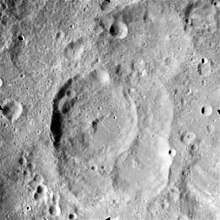Al-Khwarizmi (crater)
Al-Khwarizmi is a lunar impact crater located on the far side of the Moon. It lies to the southeast of the crater Moiseev, and northeast of Saenger.
 | |
| Coordinates | 7.1°N 107.0°E |
|---|---|
| Diameter | 56 km |
| Depth | Unknown |
| Colongitude | 254° at sunrise |
| Eponym | Muhammad ibn Musa al-Khwarizmi |

The western inner wall of Al-Khwarizmi is much wider than along the eastern side. The eastern rim overlays a pair of craters, including Al-Khwarizmi J. The outer wall is somewhat distorted from a circular shape, including a double-rim in the south. There is a small central peak at the midpoint, which forms part of a low ridge that bends to the northeast. Several tiny craterlets lie in the northern part of the interior floor. The floor to the southeast is somewhat smoother and free of significant impacts.
The crater was named for the Persian mathematician and astronomer Muhammad ibn Musa al-Khwarizmi.[1]
Satellite craters

By convention these features are identified on lunar maps by placing the letter on the side of the crater midpoint that is closest to Al-Khwarizmi.
| Al-Khwarizmi | Latitude | Longitude | Diameter |
|---|---|---|---|
| B | 9.0° N | 107.4° E | 62 km |
| G | 6.9° N | 107.1° E | 95 km |
| H | 6.0° N | 109.2° E | 50 km |
| J | 6.2° N | 107.6° E | 47 km |
| K | 4.6° N | 107.6° E | 26 km |
| L | 3.9° N | 107.4° E | 35 km |
| M | 3.1° N | 107.0° E | 18 km |
| T | 7.0° N | 104.5° E | 15 km |

 Al-Khwarizmi K crater from Apollo 11
Al-Khwarizmi K crater from Apollo 11
References
- "Al-Khwarizmi". Gazetteer of Planetary Nomenclature. USGS Astrogeology Research Program.
- El-Baz, Farouk. "Al-Khwarizmi: A New-Found Basin on the Lunar Far Side". Science, New Series, Vol. 180, No. 4091 (Jun. 15, 1973), pp. 1173–1176. Published by: American Association for the Advancement of Science.
- Andersson, L. E.; Whitaker, E. A. (1982). NASA Catalogue of Lunar Nomenclature. NASA RP-1097.CS1 maint: ref=harv (link)
- Bussey, B.; Spudis, P. (2004). The Clementine Atlas of the Moon. New York: Cambridge University Press. ISBN 978-0-521-81528-4.CS1 maint: ref=harv (link)
- Cocks, Elijah E.; Cocks, Josiah C. (1995). Who's Who on the Moon: A Biographical Dictionary of Lunar Nomenclature. Tudor Publishers. ISBN 978-0-936389-27-1.CS1 maint: ref=harv (link)
- McDowell, Jonathan (July 15, 2007). "Lunar Nomenclature". Jonathan's Space Report. Retrieved 2007-10-24.CS1 maint: ref=harv (link)
- Menzel, D. H.; Minnaert, M.; Levin, B.; Dollfus, A.; Bell, B. (1971). "Report on Lunar Nomenclature by the Working Group of Commission 17 of the IAU". Space Science Reviews. 12 (2): 136–186. Bibcode:1971SSRv...12..136M. doi:10.1007/BF00171763.CS1 maint: ref=harv (link)
- Moore, Patrick (2001). On the Moon. Sterling Publishing Co. ISBN 978-0-304-35469-6.CS1 maint: ref=harv (link)
- Price, Fred W. (1988). The Moon Observer's Handbook. Cambridge University Press. ISBN 978-0-521-33500-3.CS1 maint: ref=harv (link)
- Rükl, Antonín (1990). Atlas of the Moon. Kalmbach Books. ISBN 978-0-913135-17-4.CS1 maint: ref=harv (link)
- Webb, Rev. T. W. (1962). Celestial Objects for Common Telescopes (6th revised ed.). Dover. ISBN 978-0-486-20917-3.CS1 maint: ref=harv (link)
- Whitaker, Ewen A. (1999). Mapping and Naming the Moon. Cambridge University Press. ISBN 978-0-521-62248-6.CS1 maint: ref=harv (link)
- Wlasuk, Peter T. (2000). Observing the Moon. Springer. ISBN 978-1-85233-193-1.CS1 maint: ref=harv (link)
External links
| Wikimedia Commons has media related to Al-Khwarizmi (crater). |
